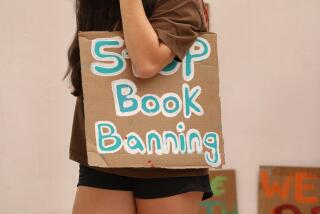Books we hate to love
- Share via
WITH “The Da Vinci Code” in the dock here in Britain, the good bad book is in the news. It’s a category that riles serious literary critics.
Reviewing Dan Brown’s bestseller, the Times of London described it as “without doubt the silliest, most inaccurate, ill-informed, stereotype-driven, cloth-eared, cardboard-cutout-populated piece of pulp fiction.” But 40 million or so buyers have been severely entertained by it -- always something that troubles the highbrows. The very literary John Updike criticized the very popular Tom Wolfe as “entertainment not literature.”
George Orwell wrote an article on good bad books just after the end of World War II. This oxymoronic category attracted the author of “Animal Farm” because he was both personally and professionally committed to slumming -- either on the streets of Paris or in the great halls of literature. Orwell said “Uncle Tom’s Cabin” would outlive Virginia Woolf. He found that you could be amused or excited by what the intellect despises. “By any test that can be devised,” Orwell wrote, “Carlyle would be found to be a more intelligent man than Trollope. Yet Trollope has remained readable and Carlyle has not.”
Good bad books are not the same as books that are merely bad. Good bad is more subtle. A good bad book is one that achieves a surprisingly exhilarating effect despite flaws of style and construction, which disqualify it as (what Updike calls) “literature.” Significantly, good bad books translate very well into film, perhaps suggesting that cinema is an intellectually and artistically undemanding medium. “The Guns of Navarone,” “The Graduate” and “Jaws,” for example, were feeble literature but made magnificent movies.
The good bad critical label can be traced to G.K. Chesterton, inspired by the extraordinary number of very bad books, ripe with imperial pomp, scintillating with sexually repressed jingoism, that were published in the Edwardian era. But boorish pulp can be enjoyable. Bad can be good.
Indeed, there may be something in our circuitry that wills confusion between these poles. Urban blacks appropriated bad to mean its opposite many years ago, and the joys of inversion were taken up at the dawn of punk by Malcolm McLaren, who said of his Sex Pistols and their epic crassness on stage: “They are so bad they are good.”
Then there are bad good books -- the ones written with high artistic purpose that fail. Ernest Hemingway, Graham Greene and, more recently, Bruce Chatwin or Salman Rushdie would be many people’s candidates here. Very high levels of critical toxicity are recorded in peer-group assessments of bad good books. For example, is Greene good? Bad? Good bad? Or bad good? Possibly all those things. Author Anthony Powell said, “He was good at reportage, a lively journalist, able businessman, but the novels are vulgarized Conrad, to which tedious Roman Catholic propaganda is added, and the occasional efforts at humor dreadful.”
Rivalry may be an issue in these judgments, as one great travel writer writing on another revealed. Jan Morris said of Chatwin: “Too much for me. Snobbism, equally camp and genuine; showy connoisseurship of a quirky kind; the deadly energy of a raconteur; the insensitivity of the tuft hunter; a gift for mimicry; sexual ambiguity of the Strength Through Joy kind.”
If there is a relish in the high-minded over recording the failures of the competition, there is also a reluctance to accept the sometimes keen pleasures of the good bad book. Brown most certainly has all the clunking faults described by the Times’ crotchety critic, but “The Da Vinci Code” is an infectious read. And if great literature is not always entertaining, there are great books and poems as cloth-eared as Brown’s book.
Alberto Manguel, Jorge Luis Borges’ amanuensis, explained how the writer used to treasure terrible lines from literature. One was a character in John Webster’s “The Duchess of Malfi” who says, “We are merely the stars’ tennis balls.” Emily Bronte’s “Wuthering Heights” contains this shocker: “I had no desire to aggravate his impatience, previous to inspecting his penetralium.”
Bad, it turns out, can be better than good and is always better than bad good, but good bad is perhaps the best of all (certainly the most entertaining). “Beowulf” has many qualities, but it is not a page-turner to rival “The Da Vinci Code.” This delicious confusion makes me feel, in Mark Twain’s execrable expression, “as sweet and contented as an angel half-full of pie.” By any test that can be devised, that’s a really bad line.
More to Read
Sign up for our Book Club newsletter
Get the latest news, events and more from the Los Angeles Times Book Club, and help us get L.A. reading and talking.
You may occasionally receive promotional content from the Los Angeles Times.







